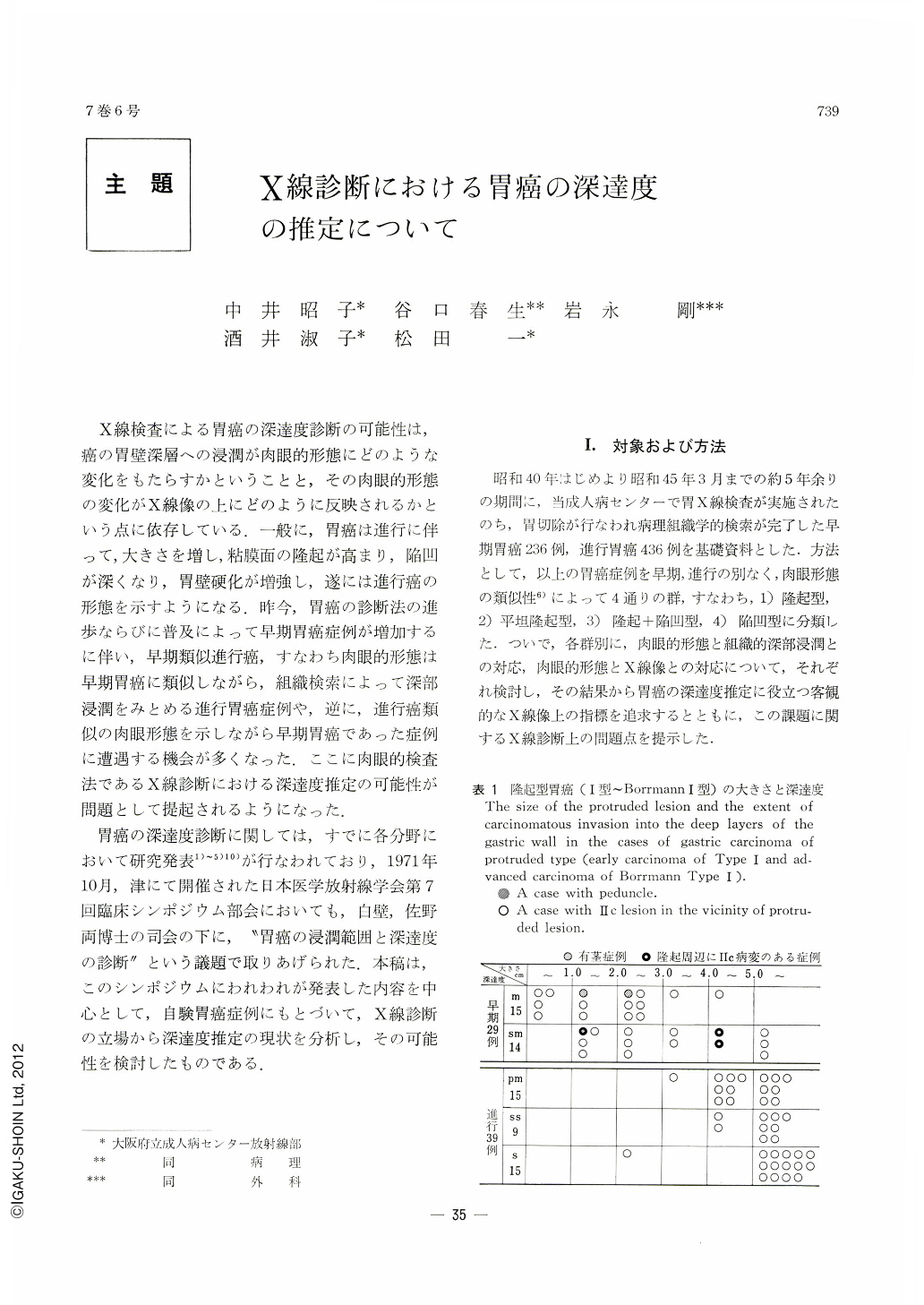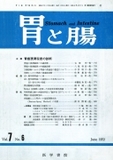Japanese
English
- 有料閲覧
- Abstract 文献概要
- 1ページ目 Look Inside
- サイト内被引用 Cited by
X線検査による胃癌の深達度診断の可能性は,癌の胃壁深層への浸潤が肉眼的形態にどのような変化をもたらすかということと,その肉眼的形態の変化がX線像の上にどのように反映されるかという点に依存している.一般に,胃癌は進行に伴って,大きさを増し,粘膜面の隆起が高まり,陥凹が深くなり,胃壁硬化が増強し,遂には進行癌の形態を示すようになる.昨今,胃癌の診断法の進歩ならびに普及によって早期胃癌症例が増加するに伴い,早期類似進行癌,すなわち肉眼的形態は早期胃癌に類似しながら,組織検索によって深部浸潤をみとめる進行胃癌症例や,逆に,進行癌類似の肉眼形態を示しながら早期胃癌であった症例に遭遇する機会が多くなった.ここに肉眼的検査法であるX線診断における深達度推定の可能性が問題として提起されるようになった.
胃癌の深達度診断に関しては,すでに各分野において研究発表が行なわれており,1971年10月,津にて開催された日本医学放射線学会第7回臨床シンポジウム部会においても,白壁,佐野両博士の司会の下に,“胃癌の浸潤範囲と深達度の診断”という議題で取りあげられた.本稿は,このシンポジウムにわれわれが発表した内容を中心として,自験胃癌症例にもとづいて,X線診断の立場から深達度推定の現状を分析し,その可能性を検討したものである.
The limitations of the radiologic method in estimating the extent of carcinomatous invasion into the deep layers of the gastric wall were evaluated on the basis of comparing the macroscopic-radiologic features with the histologic findings of the specimens in 236 cases of early gastric carcinoma and 436 of advanced one in our own material.
In gastric carcinoma of protruded type (early carcinoma of Type Ⅰ, advanced carcinoma of Borrmann Type Ⅰ, early carcinoma of Type Ⅱa and advanced carcinoma with macroscopic features resembling Type Ⅱa) the size of a tumor is essential to estimating the extent of carcinomatous invasion into the gastric wall. In the second place, the presence of a peduncle at the base of the tumor in early gastric carcinoma of Type Ⅰ and a combined depression on the very flat elevation of the mucous membrane in early gastric carcinoma of Type Ⅱa ought to be taken into consideration for the estimation of carcinomatous invasion into the gastric wall. In conclusion one is able to estimate radiologically the depth of carcinomatous invasion into the gastric wall with sufficient accuracy, since there is every possiblity of delineating these macroscopic features mentioned above by radiological method.
As to gastric carcinoma with heaped up margin and depressed center (early carcinoma of Type Ⅰ with superficial defect, early carcinoma of Type Ⅱc without converging folds and advanced carcinoma of Borrmann Type Ⅱ), carcinomatous infiltration into the gastric wall is not uncommon, even if the tumor is very small. Hence the characteristics for estimating the extent of the deeper invasion were searched for as to both macroscopic-radiologic appearances of the contour and surface of the trancelucency due to the marginal elevation and those of the contour of the central depression. A certain correlation was found between those macroscopic-radiologic appearances and the extent of the invasion of gastric carcinoma in this category. The radiographic features, however, are not always faithful to the macroscopic appearances of these lesions according to the localization of gastric carcinoma or the method of the radiologic examination employed, so that the reliability on the supposed extent of carcinomatous invasion into the gastric wall on the basis of the gross radiologic appearance should be investigated hereafter.
Concerning gastric carcinoma of depressed type, only advanced carcinoma with the macroscopic appearances resembling any one of early gastric carcinoma of Type Ⅱc with converging folds, Type Ⅱc+Ⅲ and Type Ⅲ+Ⅱc was discussed, because advanced carcinomas of this type were mostly of advanced carcino-ma in our material. The advanced carcinoma of depressed type was divided from the histopathological features of carcimatous invasion in the gastric wall into the following 3 types: 1) minimal infiltrating type, 2) diffuse infiltrating type and 3) localized infiltrating type. In the minimal infiltrating type it was almost impossible to differentiate advanced gastric carcinoma from early one, while this differentiation was not difficult in diffuse infiltrating type. The localized infiltrating type was somewhat in-between in the possibilities of estimating the extent of carcinomatous invasion into the deeper layers of the gastric wall.

Copyright © 1972, Igaku-Shoin Ltd. All rights reserved.


